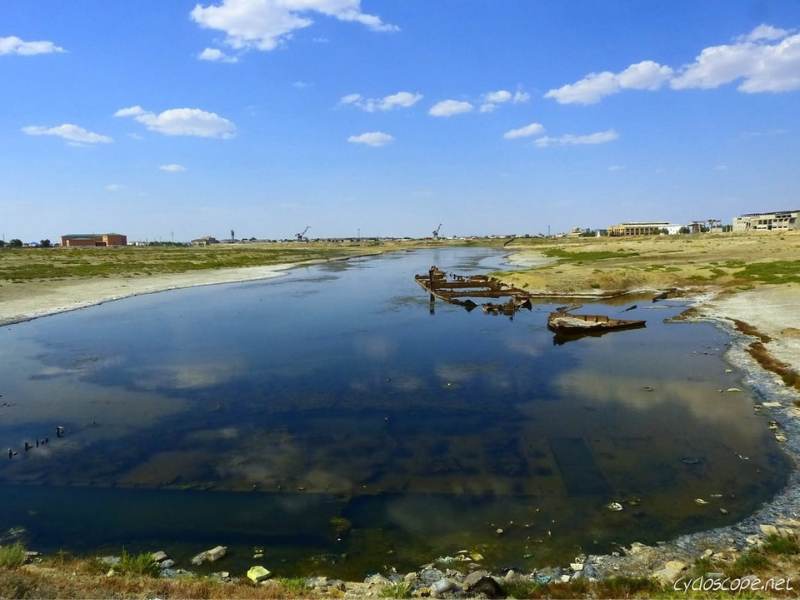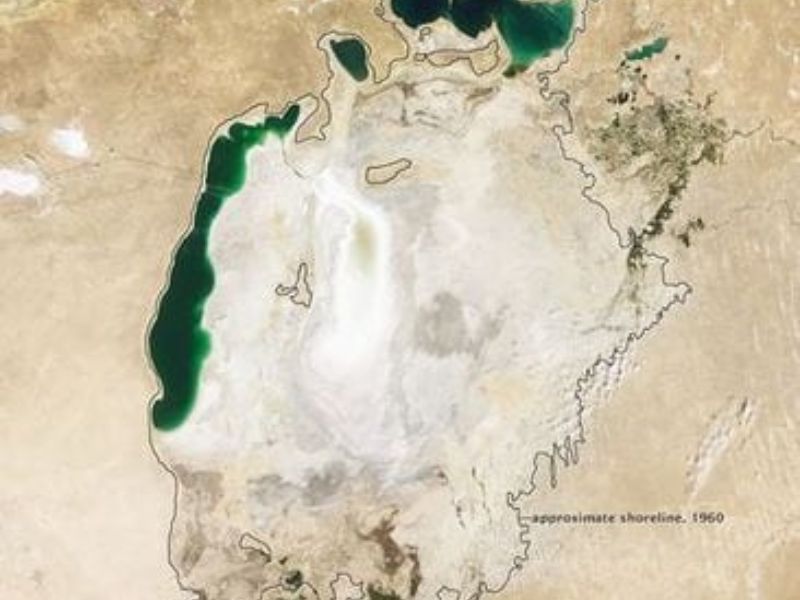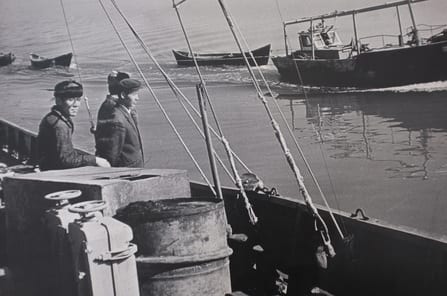Last Updated on 22 January 2025 by Cycloscope

Aral Lake used to be the 4th largest lake in the world for surface. Now is almost a pond.
Do you remember Aral Lake?
That huge pool of water just on the east side of the Caspian Sea? You don’t? Maybe you’re too young, ’cause if you looked at that after the year 2000 that doesn’t look so impressive.
Aral Lake used to be the 4th largest lake in the world for surface (68,000 square kilometers) after the Caspian Sea, Lake Superior (North America), and Lake Victoria (Africa). Now is almost a pond.
Update
After writing this article, we went to Aralsk to find out in person. We couldn’t make it to the new shore of the Aral Sea, now in the middle of the desertic steppe, impossible to reach by bicycle.
Why Aral Sea dry out
In the 1940s, the Soviet government decided to divert the Aral Sea’s main tributary rivers, Amu Darya and Syr Darya, to irrigate the desert region surrounding it, in an attempt to grow rice, cereals, and cotton.
Many of the canals were poorly built, allowing water to leak or evaporate. From the Qaraqum Canal, the largest in Central Asia, perhaps 30 to 75% of the water went to waste. Today, only 12% of Uzbekistan’s irrigation canal length is waterproofed (Wikipedia).
By 1960, between 20 and 60 cubic kilometers of water were going each year to the land instead of into the Aral. With most of its water supply gone, the Aral Sea began to shrink.
From 1961 to 1970, the Aral’s sea level fell at an average of 20 cm a year; in the 1970s, the average rate nearly tripled to 50–60 centimeters per year, and by the 1980s it continued to drop, with a mean of 80–90 centimeters each year.
By 2007, the Aral Sea had declined to 10% of its original size.
Levels of salinity

The level of salinity rose from approximately 10g/l to more than 100g/l in the remaining Southern Aral. The salinity of the rivers varies with place and time, as well as through the seasons.
When going through the desert, rivers often collect some salt compound residues in the ground that result in higher salinity, but may well be lowered again after going through irrigated lands.
Dams also affect salinity, notably by reducing its variability with the seasons.
Smaller lakes within the Aral Sea area, that have stopped being fed by river flows, tend to have higher salinity due to evaporation, causing some or all fishes that either survived or had been reintroduced in the 1990s to die.
Even re-watering those lakes does not compensate for the increased salinity over the years. In 1998, the water level was down by 20m, with a total volume of 210 km3, compared to 1,060 km3 in 1960.
Toxic sand, toxic air, toxic water

This imprudent land modification caused unexpected climate feedback, and public health issues, and devastated the once-robust fishing economy of the region, affecting the lives of millions of people in and out of the region.
Winds are now the lords of the region, blowing highly salted and toxic sand (contaminated by chemicals residuals of weapon testing, industrial projects, and so on) as far away as Scandinavia and Japan. Of course, being a plague, especially for the locals.
The ecosystems of the Aral Sea and the river deltas feeding into it have been nearly destroyed. Crops in the region are destroyed by salt being deposited onto the land. Vast salt plains exposed by the shrinking Aral have produced dust storms, making regional winters colder and summers hotter.
During a visit in 2010 ONU Secretary Ban Ki-moon declared
“It is clearly one of the worst environmental disasters in the world. I was so shocked”.
In the meanwhile, tensions are growing between Uzbekistan and Tajikistan governments.
Competition for water could become increasingly heated, as global warming and rising populations further reduce the amount of water available per capita.
We’re going to visit this place in our journey, trying to make a small contribution, at least to the visibility of this tragedy.


